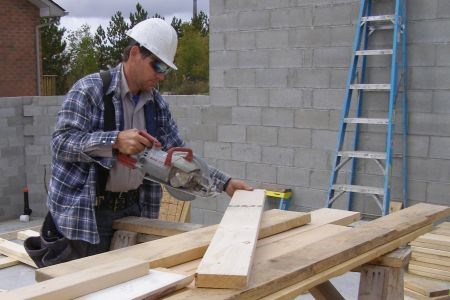To understand the City of Greater Sudbury’s newfound diversification beyond the mining industry, one need only look at the local real estate and housing markets, says Dan Gray, president of the Sudbury Real Estate Board.
Single-family housing construction starts have doubled since last year, increasing from 87 at the end of July 2009 to reach 176 to the end of July this year, according to data issued by Canada Mortgage and Housing Corporation.
“I’ve been doing this for a while, and during every mining strike, we’ve always felt the effect, but this one, we didn’t,” says Gray, who’s been in the business for 25 years.
“Obviously, we all know of people that got affected, but our overall market didn’t get affected.”
The numbers for the region tell the tale, he says: in 2009, the average sale price for a Sudbury home was $205,333; rather than sink, that price rose this year to $235,309.
Resale numbers are equally high for the first half of 2010. While there were 792 sold between January and June 2009, the same period in 2010 recorded 1,166 sales. Typically, these have averaged between 1,200 and 1,400 square feet.
Despite this rise, listings have only increased 15 per cent, making the market rather tight, says Gray. He expects the market to strengthen dramatically now that local labour uncertainties have lifted. “Sales are up substantially.
“It’s amazing, especially given what we’ve been through in the last year.”
The high-end market has also seen surprising levels of activity, says Gray.
Three homes priced between $400,000 and $500,000 were sold in the first six months of 2009; 11 were sold through to the end of June this year.
Much of this is a reflection of the city’s economy growing beyond mining into a centre of education, government and retail, he says, though he expects the market would have become affected had the strike extended beyond a year.
Despite this positivity, people have been focused largely on cost versus location, he says.
It’s a perspective that has also carried over to new home construction. New construction is thriving around the outskirts in surrounding areas such as Garson, Lively, and Val Caron, where costs are lower at the expense of a minor commute to the heart of Sudbury.
Indeed, the total of single-housing starts for the month of July hit 37, up 12 per cent from the same time last year.
These figures are positive, though a dip in demand for new homes is expected in the second half of the year, according to Laura Higgs, executive director of the Sudbury Home Builders Association.
The general state of the economy is one factor, but others include the municipality’s institution of development charges, the Bank of Canada’s interest rate increases, and a variety of rule changes in theCanadian Mortgage and Housing Corporation’s (CMHC) approach for new homebuyers.
Another knock against new starts is the implementation of the Harmonized Sales Tax (HST), says Higgs. New rules surrounding this tax mean that an additional $8,000 in taxes are now required for every $100,000 to be spent on new homes above $400,000.
Initially, the provincial threshold for this new tax was $327,000, a total that was pushed to its current barrier of $400,000 through lobbying by the provincial Home Builders Associations.
“Still, it’s a fair chunk of change, for sure,” says Higgs.
The HST also harms Northern builders by encouraging and strengthening operators in the so-called “underground economy,” she adds, something that has an estimated $150-million impact on the region.
To dampen its impact, the Sudbury Home Builders Association is advocating that the province require all builders to register with the HST. Similarly, strong lobbying is also occurring for the feds to institute a permanent 2.5 per cent home renovation tax rebate.
In the meantime, Higgs expects the coming year will bring renewed growth for new housing starts in 2011, once the stock of homes in the resale market begins to wane.
“There’s been a bit of a drag in our economy,” says Higgs. “I think once there’s more confidence back in the market, you’ll start to see people make those kinds of investments again.”
It’s a viewpoint that’s supported by the CMHC, whose spring outlook for Greater Sudbury indicates expectations for higher employment in the city through 2011, alongside a strong rise in local consumer spending.
While in-migration to the city will slow through the next 20 years, Sudbury’s local population of seniors is set to double, according to those same CMHC reports. This will also increase the city’s growing appeal as a location for retirement living, something that is being born out in the rise in condominium construction.
This includes a $2.4-million, 13-unit condo being built on Caswell Road, as well as a $3.4-million, 12- nit condo being built on Paris Street. These are but two examples being driven by the successful occupation of multiple condos built through the end of last year, say city officials.
General apartment and multi-unit construction is also up through the city as business interest and employment begin to rise.
Rental vacancy rates have returned to roughly 3 per cent, up from the record low of 0.6 per cent seen during the height of the nickel boom in 2007.
As a comparison, this closely matches rental vacancy numbers seen in major Canadian centres like Toronto, Halifax and Montreal, according to a study by the CMHC.
Such figures are typically lower through most of the North’s five major cities: North Bay has a rate of 1.1 per cent, while Sault Ste. Marie has 1.2 per cent, and Timmins 1.6 per cent. Thunder Bay comes the closest with 2.3 per cent.
This hasn’t stopped builders from proposing a number of new projects, including a $11.6-million, 64-unit apartment on Copper Street, or an 80-unit, $10.6-million apartment on Mont Adam Street.




